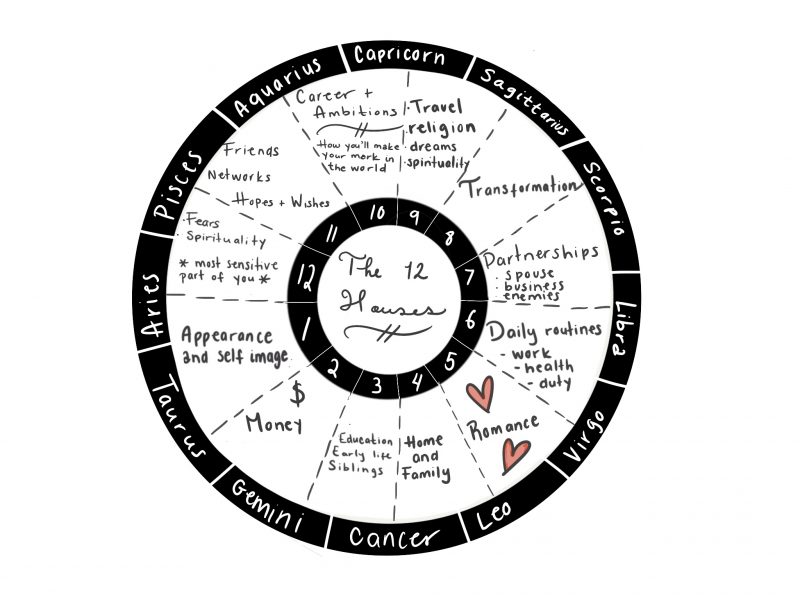With the sudden rise of Astro-enthusiasts, “what’s your sign?” has become a popular conversation starter. The stigma attached to astrology has receded as the practice has grabbed a foothold in online culture — especially for young people. Though it has been destigmatized over the last couple of years, skeptics still argue that the planets cannot influence our behaviour nor cause significant life events.
As an astrologer of five years, and also as someone who is incredibly interested in physics and psychology, I couldn’t agree more with this idea. I began questioning astrology and became fascinated with finding the real correlation between stellar and planetary phenomena, and the human being.
When looking at your birth chart, an astrologer can see all projections of your life; it’s the window to your essence. To picture your chart, think of a pie cut in 12 slices, one slice for each zodiac sign. Every slice represents a different aspect of your life and is called a “house.” In astrology, planets, constellations and their locations in our “houses” are of great importance, since every position holds a different meaning. The first house rules appearance. The second house rules how you deal with money, property, and possessions. The third is communications, fourth is all things domestic, fifth is romance and creativity, and so on.
Perhaps you have encountered a horoscope that, in theory, should resonate with you, but doesn’t. Why is this? Astrology explains that an individual is not only one sign, but a combination of all the signs and planets with different polarities, aspects and degrees, all of which hold different meanings.
Cave markings in Lascaux, France made during the Paleolithic period show that the first celestial patterns observed were the changing positions of the sun as our days turned into nights. Also observed were women’s menstruation cycles, which correlated with the moon’s cycles, both of which last 28 days. The first developed astrological scriptures can be found under the name Jyotisha, within the Vedas — a collection of hymns and ancient religious texts written in India between 1500 and 1000 BCE. With time, astrology made its way to the Western world, the Greeks, and the Babylonians, and thus western astrology was born.
Western astrology differs from the Vedic one because it considers the discovery of the Precession of the Equinoxes, which is the astronomical concept that shows how constellations move one degree every 71.5 years, meaning that the original astrological zodiac signs are now purely symbolic. This symbolism and the meaning behind it is what sparked the interest of 20th century psychiatrist and psychoanalyst Carl Jung.
Mentored by Freud and a friend of Einstein, Jung was inspired to research the metaphysical field to see if it could help him with his patients. He is considered to be the father of synchronicity, and coined the term when he noticed the correlation — but not causation — of lunar patterns and women’s menstrual cycle.
Einstein’s theory of relativity is what ultimately got Jung to consider the relativity of time, space and their psychic conditionality, and led him to write his thesis on psychic synchronicity. He discovered that, by trying to judge astrology by real-world rules, we ignore the fact that synchronicity occupies a different space. There is a part of the world that we can’t see, a realm of reality that doesn’t consist of material things, that consists of non-material forms.
Jung concluded that, in the same way that the moon synchronizes with but does not cause the female menstruation cycle, celestial conjunctions are but a mere reflection and a great example of how everything is connected; everything is in sync. Planets and constellations are archetypes — a collection of the basic themes that make up our human lives. They are components of the human psyche that are found in the collective unconscious. The collective unconscious is a part of our unconscious mind that derives from ancestral memory and its experience is common to all humankind; history repeats itself, and our ancestors noticed. From this, all the archetypes found in astrology, Tarot, Runes, and all the other metaphysical divinatory practices were created — it’s all the same concept.
The human psyche is a self-regulating system like the human body. It strives to maintain a balance between opposing qualities while simultaneously actively seeking its own personal development.
Despite what popular mainstream astrology pages say, these archetypes do not define you or cause any significant or minor life event, good or bad. It is your free will and the choices you make in life that ultimately determine who you are. The real purpose of astrology is not to impose personality traits. With your natal chart, you will realize that your goals become clearer because you can figure out exactly where your strengths and weaknesses lie. It is the blueprint to your path to success and individuality.
Graphic courtesy of writer.





Comments are closed.